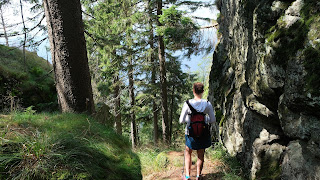Sabah, Borneo, was wonderful, as I expected, but we never saw any Orangutans in the wild. We saw two semi-wild ones at the Rehabilitation Centre in Sepilok, as well as many young ones still in rehab, but I was really hoping to see at least one in the wild, which is the impression I got from reading birding and mammal watching trip reports. Of course, there are no guarantees when it comes to seeing wildlife, but ... I can’t help but feel somewhat disappointed.
Our trip started in Singapore where we visited both the Botanic Gardens and the Gardens by the Bay, and I can say with certainty that the Botanic Gardens are much nicer than the Gardens by the Bay. The gigantic artificial trees were just too much for me. We also opted for a river cruise on a bumboat instead of seeing Singapore from the top of the Marina Bay Sands complex, which was the right choice. We saw more of Singapore's neighborhoods at river level than we would have from the top of the overwhelmingly tall, and wide, Marina Bay Sands.
From Singapore, we flew to Kota Kinabalu for one night and enjoyed the food at the Gaya Street Night Market. We rented a car to be flexible and drove to Mount Kinabalu National Park and Poring Hot Springs. We stayed in a lovely two-bedroom cabin at the Sutera Sanctuary Resort at Poring Hot Springs, which Alex liked because he had his own room. Alex considered climbing Mt Kinabalu but decided against it because the guide and overnight accommodations on the mountain cost about 600 Euros. It was a good decision because it rained every day we were there, and we only saw the peak on our last day. We had plenty to do anyway: hiking, birding on the canopy walkway and soaking in the Sulphur Springs.
After returning the car in Sandakan, we spent six days in the rainforest, first in Sepilok, where we saw the only Orangutans we were going to see and Sun Bears at the Bornean Sun Bear Conservation Centre, and then at Sukau Rainforest Lodge on the Kinabatangan River and Utan Rainforest Lodge in the Tabin Wildlife Reserve. The river is good for seeing monkeys, Proboscis monkeys, Long-tailed and Short-tailed Macaques, and Langurs, and we did see plenty of the Proboscis monkeys and Macaques. It is also supposed to be a good place to see Orangutans and Bornean Pygmy Elephants. The former we did not see, as I already mentioned, and as for the latter, we saw only their tracks along the river. The elephants come down from the palm oil plantations to bathe but not at any one specific time (they obviously need wrist watches), so we missed seeing them that particular day. We did, though, see a plethora of birds, crocodiles and smaller mammals, especially during the night cruises and walks.
Like I said, I was disappointed that we didn’t see Orangutans in the wild, but I did get to spend time doing things I like doing (hiking, birding, mammal watching, snorkeling) with Bob and Alex. Besides, even if we didn’t see the Orangutans, maybe they saw us, as Alis suggested. I like this thought and the idea of going back to Borneo.






















































